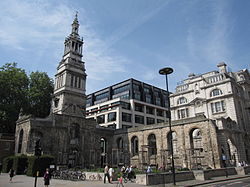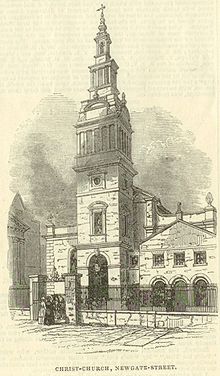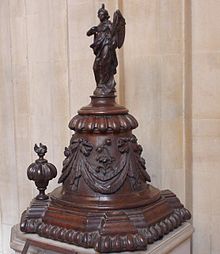- Christ Church Greyfriars
-
Christ Church Greyfriars
Christ Church Greyfriars, seen from the southeastCountry United Kingdom Denomination Roman Catholic, Anglican Christ Church Greyfriars, also known as Christ Church Newgate, was an Anglican church located on Newgate Street, opposite St Paul's Cathedral in the City of London. Built first in the gothic style, then in the English Baroque style by Sir Christopher Wren, it ranked among the City's most notable pieces of architecture and places of worship[1]. The church was destroyed in the Second World War; the ruins are now a public garden.
Contents
History
Gothic church
The first church was constructed between 1306 and 1348[2] as the conventual church of a Franciscan monastery established on the site. (The Franciscans' practice of wearing grey habits accounts for the word "Greyfriars" in the name.) This church was in the gothic style and ranked as the second-largest in medieval London, measuring 300 feet (91 m) long by 89 feet (27 m) across.[3] It had at least 11 altars. Extensive royal patronage helped it prosper. Benefactors included Marguerite of France, second wife of King Edward I. She was buried at the church, as was Isabella, widow of Edward II; the heart of Eleanor of Provence, wife of Henry III, was interred there as well.
Following the Dissolution of the Monasteries, in 1538, King Henry VIII gifted the church to the City. The building and fittings suffered heavy damage in this period. Tombs disappeared, sold for their marble and other valuable materials; monuments were defaced. Neighbouring monastery buildings were later used by Christ's Hospital, for whose students the church became the principal place of worship[4].
Wren's church
The Gothic church was destroyed by the Great Fire of London in 1666. Reconstruction was assigned to Wren, who oversaw a decades long-program that rebuilt St. Paul's Cathedral and approximately 50 parish churches in the fire zone. There appears to have been some debate about the form the new Christ Church should take. An unused design that would have created a structure considerably larger than what was eventually built has survived.
Parishioners raised 1,000 pounds to begin work on the design that in the end was selected. To save time and money, the foundations of the gothic church were partially reused. The new church and tower (without steeple) were completed in 1687, at a total cost of 11,778 pounds, 9 shillings and 7 ¼ pence.[5] Smaller than the gothic structure, the building measured 113 feet (34 m) long, covering what was the choir area of the old church's eastern side; the area of the former nave became the churchyard. The new creation was a prime example of the neo-classical style that came to be known as the English Baroque.
The tower, rising from the west end of the church, had a simple round-arched main entranceway and, above, windows decorated with neoclassical pediments. Large carved pineapples, symbols of welcome, graced the four roof corners of the main church structure. Unique among the Wren churches, the east and west walls had buttresses.
Inside, the overall sense was of greater ornamentation. The nave had two rows of five grand columns, topped with elaborate capitals, running east to west, with pilasters on the east and west walls. The north and south walls had large round-arched windows of clear glass, which allowed for a brightly-lit interior. The east end had trinity windows, a large wooden altar screen and a carved hexagonal pulpit, reached by stairs. There was elaborate carved wainscoting. Pavement of reddish brown and grey marble to the west of the altar rails was said to date from the original gothic church. Galleries stood over the north and south aisles, built at special request of the officers of Christ's Hospital as seating for the school's students. Pews were said to have been made from the timbers of a wrecked Spanish galleon.
The organ, located on the west wall over the main nave door, was built by Renatus Harris in 1690, according to a pre-war guide to the church.
The steeple, standing about 160 feet (49 m) tall, was finished in 1704 at an additional cost of 1,963 pounds, 8 shillings and 3½ pence.[6] It is an ornate series of receding squares, with decorative urns at one of its stages.
Over the course of the church’s life, significant modifications were made. In 1760, a vestry house was built flush against the facade’s south side and part of the church's south wall. At some point, rooms were enclosed in the north and south aisles beneath the galleries. Stained glass depicting Jesus with the children was installed in the centre trinity window to replace the original clear glass.
The church functioned as an important centre of City of London society and music. The Lord Mayor attended an annual service to hear the Ancient Spital Sermon on the second Wednesday after Easter, placing his ceremonial sword in a special holder. Felix Mendelssohn played Bach's A minor fugue and other works on the organ in 1837. Samuel Wesley also performed at the church.
The Christ's Hospital boys continued to attend services, sitting in the galleries. According to the pre-war guide book to the church, they included the young Samuel Coleridge and Charles Lamb. Sixth Form boys tasked with maintaining order sat in special seats placed over those of the younger students. A few boys carved initials in the woodwork.
Final years of the congregation
Around the turn of the 20th century, Christ's Hospital moved out of the City to Horsham, West Sussex, ending the Sunday influx of its schoolboys. A new vicar, T.R. Hine-Haycock, took over in 1912. A July 1922 Christ Church newsletter preserved at Guildhall Library shows that at that time it had an 8:30 a.m. Holy Communion service every Sunday, and musical services at 11 a.m. every first and third Sunday. The church was open daily for private prayer from noon to 3 p.m. In its final years, the congregation continued to drop in size, a common trend for City churches as people relocated to suburban neighborhoods of London. Parish records at the Guildhall Library show there were 112 members in April 1933, most of them residents of places outside the parish boundaries. Many of those who made their homes in the parish were "housekeepers," people who lived in and looked after commercial buildings. In April 1937, the membership had dropped to 77.
Destruction
The church was severely damaged in the Blitz on December 29, 1940, during the Second World War, in one of the war's fiercest air raids on London. A firebomb struck the roof and tore into the nave.[7] Much of the surrounding neighbourhood was also set alight—a total of eight Wren churches burned that night. At Christ Church, the only fitting known to have been saved was the cover of the finely carved wooden font, recovered by an unknown postman who ran inside as the flames raged. The roof and vaulting collapsed into the nave; the tower and four main walls, made of stone, remained standing but were smoke-scarred and gravely weakened. A photograph taken in the light of the following day shows two firemen hosing down smouldering rubble in the nave.
Post-war period
In 1949, in a reorganisation of Church of England parishes in London, authorities decided not to rebuild. In 1954, its parish was merged with that of the nearby St Sepulchre-without-Newgate. The spire, still standing after the wartime fire, was disassembled in 1960 and put back together using modern construction methods. The surviving east wall was demolished in 1962 to make way for a widening of King Edward Street. In 1981, neo-Georgian brick offices were constructed against the southwest corner of the ruins, in imitation of the 1760 vestry house that had been in that place. In 1989, the former nave area became a public garden and memorial.[8] The tower functioned as commercial space, although it has now been converted into a private residence [9].
In 2002, the financial firm Merrill Lynch completed a regional headquarters complex on land abutting to the north and the west. In conjunction with that project, the Christ Church site got a major renovation and archeological examination. Construction workers put King Edward Street back to its former course so that the site regained its pre-war footprint. The churchyard was spruced up, its metal railings restored. In 2006, work was completed to convert the tower and spire into a modern twelve-level private residence. The nave area continues as a memorial; the wooden font cover, topped by a carved angel, can today be seen in the porch of St Sepulchre-without-Newgate.
The remains of the church were designated a Grade I listed building on 4 January 1950.[10]
Burials
- Elizabeth Barton (the 'mad maid of Kent')
- Richard Baxter (theologian)
- Venetia Stanley (Society beauty)
- Isabella of France (Queen of England)
- Thomas Mallory (author)
- Marguerite of France (Queen of England)
- Joan of The Tower (Queen of Scotland)
- Margaret, Duchess of Norfolk (noblewoman)
- Isabella de Coucy (princess)
Notes
- ^ Cobb The Old Churches of London p59
- ^ "The London Encyclopaedia" Hibbert,C;Weinreb,D;Keay,J: London, Pan Macmillan, 1983 (rev 1993,2008) ISBN 978-1-4050-4924-5
- ^ Bradley/Pevsner, London: The City Churches p. 53.
- ^ "The Visitors Guide to the City of London Churches" Tucker,T: London, Friends of the City Churches, 2006 ISBN 0955394503
- ^ Jeffery, The City Churches of Sir Christopher Wren p. 191.
- ^ Jeffery, The City Churches of Sir Christopher Wren p. 191.
- ^ Bell and Reynes, Christchurch, Newgate Street: Its History and Architecture p. 33.
- ^ Bradley/Pevsner, London: The City Churches p. 54.
- ^ http://www.foxtons.co.uk/search?property_id=665031
- ^ Details from listed building database (199669) . Images of England. English Heritage. accessed 23 January 2009
See also
- List of Christopher Wren churches in London
- List of churches rebuilt after the Great Fire but since demolished
References
- Jeffery, Paul. The City Churches of Sir Christopher Wren. The Hambledon Press 1996. ISBN 1852851422
- Bell, Derek and Reynes, Malcolm. Christchurch Newgate Street: Its History and Architecture Bene Factum Publishing Ltd. for Christchurch Group of Companies 1997.
- Bradley, Simon and Pevsner, Nikolaus. London: The City Churches. New Haven, Yale, 1998. ISBN 0300096550
- Cobb,G The Old Churches of London: London, Batsford,1942
External links
 Media related to Christ Church Greyfriars at Wikimedia Commons
Media related to Christ Church Greyfriars at Wikimedia Commons- Christ Church tower
- Christening, marriage and burial register of Christ Church Newgate for years 1538-1754
Coordinates: 51°30′56.94″N 0°5′56.93″W / 51.5158167°N 0.0991472°W
Categories:- British churches bombed by the Luftwaffe
- Buildings destroyed during World War II in the United Kingdom
- Christopher Wren churches in London
- Churches in the City of London, of which only the tower remains
- English Baroque architecture
- Grade I listed churches in London
- Preserved ruined churches of World War II
- Ruins in London
- Surviving Christopher Wren London churches
Wikimedia Foundation. 2010.



